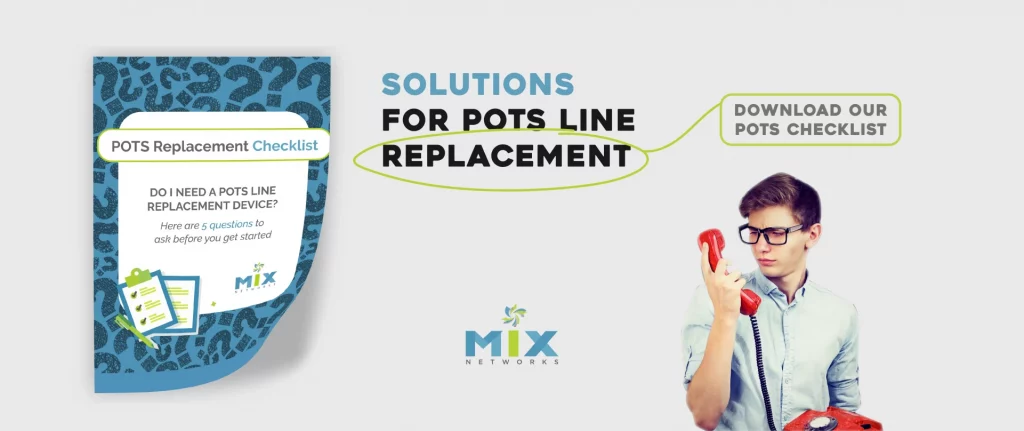In the rapidly evolving landscape of business telecommunications, a silent revolution is underway. Plain Old Telephone Service (POTS) lines, the backbone of enterprise communication for over a century, are facing an unprecedented decline. This shift isn’t just a trend—it’s a critical juncture demanding immediate attention from businesses of all sizes. The need for POTS line replacement for enterprises has never been more pressing.
The Twilight of POTS: Why Enterprises Must Act Now
For decades, POTS lines were the gold standard of reliability in enterprise communication. Their dependability during power outages and universal presence made them the default choice for critical systems like emergency services, alarm systems, and elevator communications. However, in 2024, the very qualities that once made POTS indispensable are accelerating its obsolescence in our digital age.
Major telecommunications carriers, with the Federal Communications Commission’s (FCC) tacit approval, are aggressively phasing out POTS services. This vendor discontinuation isn’t a distant threat but an immediate reality that enterprises must confront, making POTS line replacement for enterprises an urgent priority.
The Rising Costs of Delaying POTS Line Replacement for Enterprises
The financial implications of clinging to POTS lines are becoming increasingly untenable:
- Skyrocketing Maintenance Costs: As the user base dwindles, many businesses report annual price hikes of 100% or more for POTS services.
- Shrinking Expert Pool: The scarcity of technicians skilled in POTS infrastructure leads to longer downtimes and more challenging repairs.
- Reliability Concerns: Each moment of downtime represents lost productivity, potential safety risks, and possible regulatory non-compliance.
Technological Limitations: Why POTS Line Replacement is Crucial for Enterprise Growth
In an era where digital transformation is necessary for survival, POTS lines represent a significant bottleneck:
- Limited Functionality: POTS lines are restricted to basic voice capabilities, lacking advanced features like video conferencing and integration with digital business tools.
- Competitive Disadvantage: Enterprises relying on POTS risk falling behind competitors who have adopted modern, feature-rich communication systems.
Security Vulnerabilities: A Key Driver for POTS Line Replacement in Enterprises
In today’s landscape of constant cyber threats, the security vulnerabilities of POTS lines are a significant concern:
- Outdated Protocols: POTS systems use older, less secure protocols, making them susceptible to eavesdropping and other security threats.
- Regulatory Risks: For enterprises handling sensitive information or operating in regulated industries, these vulnerabilities present an unacceptable risk.
The Compatibility Challenge in POTS Line Replacement for Enterprises
One of the most significant hurdles in transitioning away from POTS lines is legacy equipment compatibility:
- Hardware Upgrades: Many enterprises must upgrade or replace equipment like phone systems, fax machines, and security alarms to ensure compatibility with new VoIP or digital phone services.
- Regulatory Compliance: Some industries have specific requirements for maintaining POTS lines for certain applications, complicating the transition process.
The Path Forward: Strategies for Successful POTS Line Replacement in Enterprises
While the challenges of replacing POTS lines are significant, the benefits far outweigh the costs. By transitioning to modern digital communication systems like Voice over Internet Protocol (VoIP), enterprises can:
- Significantly reduce long-term communication costs
- Enhance functionality and integration with other business systems
- Improve scalability and flexibility in their communication infrastructure
- Boost productivity through advanced features and better collaboration tools
- Strengthen security and compliance measures
- Future-proof their communication systems against further technological changes
Planning Your Enterprise’s POTS Line Replacement Strategy
For a successful transition, enterprises need to consider:
- Infrastructure Upgrades: Assess and upgrade network infrastructure to support digital communications.
- Training and Change Management: Implement comprehensive programs to ensure smooth adoption of new systems.
- Reliability and Redundancy: Ensure new systems maintain or exceed the reliability of POTS, especially for critical functions.
- Cost-Benefit Analysis: Carefully evaluate the initial investment against long-term savings and benefits.
Conclusion: The Time for POTS Line Replacement in Enterprises is Now
The decline of POTS lines is not just a technological shift; it’s a wake-up call for enterprises. By proactively addressing POTS line replacement, businesses can mitigate risks, reduce costs, and position themselves at the forefront of communication technology.
As we bid farewell to the era of POTS lines, we must ensure a smooth transition to modern communication systems that can match and exceed their legacy of reliability and universal service. The future of enterprise communication is digital, integrated, and infinitely more capable than the POTS lines of yesteryear.
For enterprises ready to embrace this future, the opportunities are boundless. The question is not whether to make the transition, but how quickly and effectively it can be accomplished. Don’t let your enterprise fall behind—start planning your POTS line replacement strategy today.
Keep Reading:
POTS Line Replacement Myths Debunked
Comparing POTS Line Replacement Providers: What You Need to Know
Advantages of Replacing POTS Lines with Digital Communications









